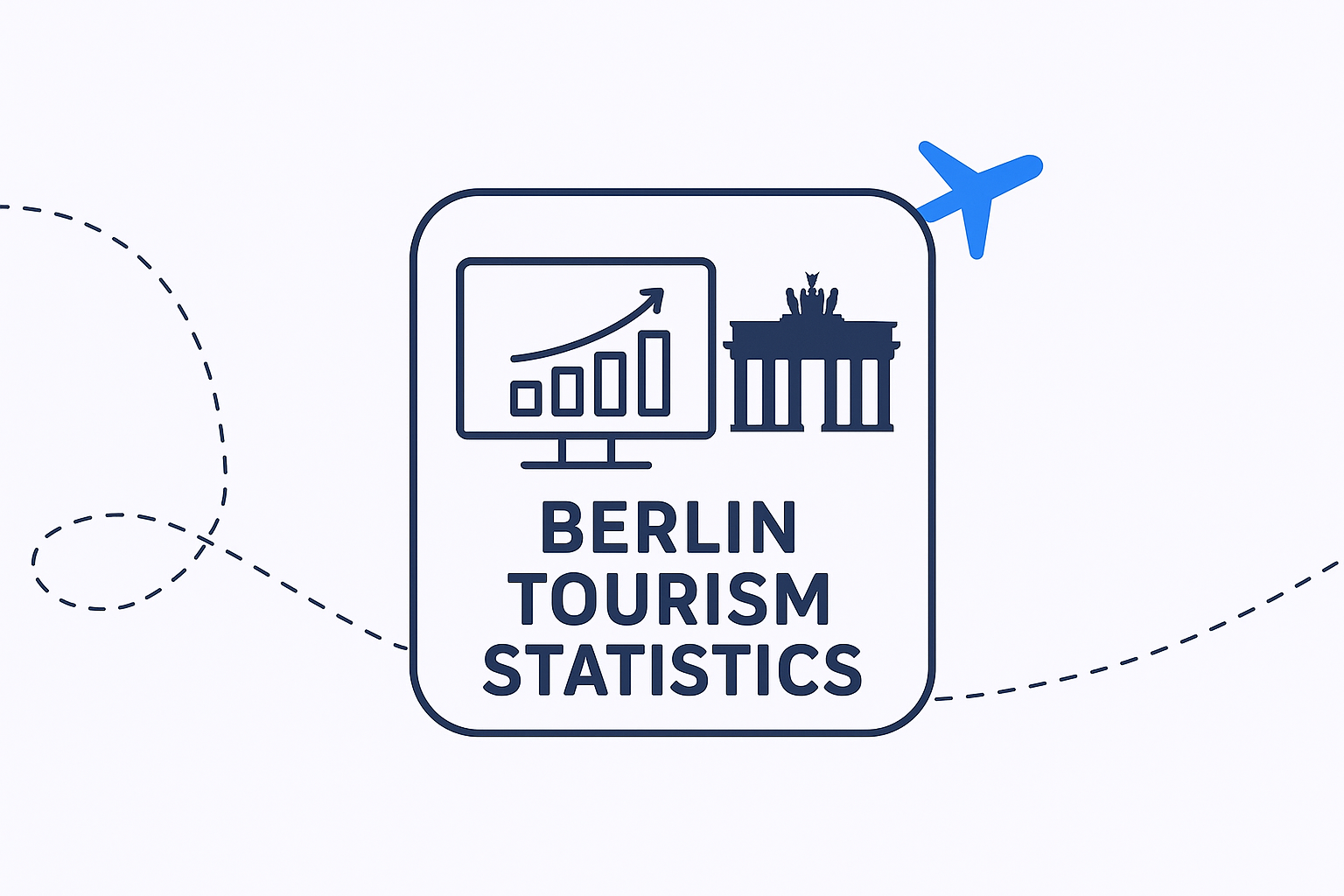Berlin isn’t just Germany’s capital — it’s one of Europe’s most magnetic city destinations.
Ranking as the 8th most visited city in Europe, Berlin welcomed around 13.5 million visitors in 2024, generating more than 30 million overnight stays.
The city blends turbulent history, vibrant nightlife, and cultural landmarks, making it a must-see for millions every year.
Among its attractions, the Berlin Zoo leads the charts, drawing an impressive 3.3 million visitors annually — more than any single museum or paid site in the city.
From the Brandenburg Gate to the Berlin Wall, the numbers show why Berlin continues to be a powerhouse of European tourism.
How Many Tourists Visit Berlin Each Year?
In 2024, Berlin welcomed 13.5 million visitors, marking a strong recovery after the pandemic.
These tourists booked 30 million overnight stays, making Berlin one of Europe’s busiest city destinations.
Domestic travelers accounted for about 56%, while international arrivals made up the remaining 44%.
How Much Do Visitors Spend in Berlin?
Tourism is a major economic driver for Berlin.
In 2023, visitors spent an estimated €11 billion in the city, supporting everything from hotels and restaurants to museums and events.
The average daily spend per visitor was €210, higher than many other European capitals.
Which Countries Visit Berlin the Most?
Berlin attracts a broad mix of travelers, but Europeans dominate.
Germany itself accounts for more than half of all visitors, followed by strong flows from the UK, the US, the Netherlands, and Italy.
Asian tourism, especially from China and Israel, is steadily increasing as long-haul travel resumes.
| Country | Share of Visitors |
|---|---|
| 🇩🇪 Germany (domestic) | 56% |
| 🇬🇧 United Kingdom | 6% |
| 🇺🇸 United States | 6% |
| 🇳🇱 Netherlands | 5% |
| 🇮🇹 Italy | 4% |
| 🇪🇸 Spain | 3% |
| 🇫🇷 France | 3% |
| 🇨🇳 China | 2% |
| 🇮🇱 Israel | 2% |
| 🇩🇰 Denmark | 2% |
What Are Berlin’s Most Visited Attractions?
Berlin’s appeal is a mix of historical depth and cultural energy.
The Berlin TV Tower (Fernsehturm) leads with 1.2 million visitors annually, closely followed by the Pergamon Museum on Museum Island.
Outdoor landmarks like the Berlin Wall Memorial and the Brandenburg Gate attract millions more, even if not all visits are ticketed.
| Attraction | Annual Visitors |
|---|---|
| Berlin TV Tower (Fernsehturm) | 1.2M |
| Pergamon Museum | 1.1M |
| Neues Museum | 0.8M |
| Altes Museum | 0.5M |
| Berlin Zoo & Aquarium | 3.3M |
| Berlin Wall Memorial | ~2.0M |
| Brandenburg Gate | ~10M (est., free site) |
| East Side Gallery | ~3M |
| Charlottenburg Palace | 0.5M |
| GDR Museum | 0.6M |
When Is the Best Time to Visit Berlin? (Seasonality)
Berlin’s seasonality is defined by summer peaks and steady cultural tourism in winter.
July and August are the busiest months, with hotel occupancy often exceeding 80%, while January and February remain quieter.
Christmas markets in December provide another tourism surge.
| Month | Visitors (Hotel Stays) | Notes |
|---|---|---|
| January | ~1.5M | Low season, cultural tourism |
| February | ~1.6M | Berlinale Film Festival |
| March | ~2.0M | Spring conferences |
| April | ~2.2M | Easter tourism |
| May | ~2.5M | Start of high season |
| June | ~2.7M | Summer build-up |
| July | ~3.0M | Peak season |
| August | ~3.1M | Peak season |
| September | ~2.6M | IFA & events |
| October | ~2.4M | Autumn city breaks |
| November | ~1.9M | Lower season |
| December | ~2.1M | Christmas markets |
What Are the Biggest Events Attracting Tourists to Berlin?
Berlin’s event calendar is world-famous.
The Berlinale Film Festival each February brings ~330,000 film fans and industry guests, while the Berlin Marathon attracts 45,000 runners plus thousands of spectators.
Summer’s Christopher Street Day (Pride) gathers nearly 1 million people, making it one of the largest LGBTQ+ events in Europe.
The city’s Christmas Markets attract around 4 million visitors annually.
| Event | Annual Visitors | Notes |
|---|---|---|
| Berlinale Film Festival | ~330K | One of the world’s top film festivals |
| Christopher Street Day (Pride) | ~1M | Major LGBTQ+ celebration in July |
| Berlin Marathon | 45K runners + 1M spectators | September sporting event |
| Carnival of Cultures | ~1.5M | Multicultural parade in May |
| New Year’s Eve Brandenburg Gate | ~1M | Europe’s biggest open-air party |
| Christmas Markets | ~4M | Over 80 markets across the city |
| Long Night of Museums | ~30K | Special museum night each August |
| Fête de la Musique | ~100K | June open-air concerts |
| Berlin Art Week | ~120K | Contemporary art festival in September |
| IFA Berlin | ~250K | Global tech fair in September |
How Does Tourism Impact Berlin’s Economy?
Tourism is a cornerstone of Berlin’s economy.
The sector supports around 235,000 jobs and contributes €11 billion annually.
Hotels alone employ 30,000 people, while events like the Berlinale and IFA generate global media exposure.
Berlin’s relatively affordable prices compared to Paris or London also make it a popular city break.
What Challenges Does Berlin Face in Tourism?
Berlin faces challenges common to many popular European cities:
- Overtourism in Mitte and Kreuzberg, where residents complain of rising rents.
- Balancing business vs. leisure tourism — as conferences and trade fairs compete with leisure visitors.
- Sustainability goals, with the city aiming to reduce emissions and promote greener mobility.
FAQ – Berlin Tourism Insights
How many tourists visit Berlin each year?
Around 12.1 million visitors in 2023, generating 28.6 million overnight stays.
What’s Berlin’s most visited attraction?
The Berlin TV Tower with 1.2 million ticketed visitors annually, but free sites like the Brandenburg Gate see far more foot traffic.
How much do tourists spend in Berlin?
Tourism spending totals around €11 billion annually.
When is the best time to visit Berlin?
May to September is peak season, while December’s Christmas markets bring winter crowds.
Which event draws the biggest crowd?
Christopher Street Day (Pride) with ~1 million participants, and the Christmas markets, which attract ~4 million visitors.
What is Berlin ranked in tourism?
Berlin ranks as the 8th most visited city in Europe and consistently appears in the top 20 worldwide.
Is Berlin a popular tourist destination?
Yes — Berlin is one of Europe’s most visited capitals, known for its mix of history, art, nightlife, and cultural events.
Which part of Berlin is richest?
The district of Charlottenburg-Wilmersdorf is considered one of the wealthiest, featuring luxury boutiques, embassies, and upscale housing. Zehlendorf is also known for its affluent residents and leafy villas.
Where not to stay in Berlin as a tourist?
While Berlin is generally safe, some neighborhoods like parts of Neukölln or Marzahn-Hellersdorf may feel less welcoming late at night due to higher petty crime rates or lack of tourist infrastructure. Most central districts (Mitte, Prenzlauer Berg, Charlottenburg, Kreuzberg) are safe and tourist-friendly.
Why is Berlin so popular?
Berlin’s appeal comes from its unique blend of history and modernity: Cold War heritage (Berlin Wall, Checkpoint Charlie), world-class museums, alternative nightlife, affordable food, and vibrant festivals.
Is Berlin cheap or expensive?
Compared to London or Paris, Berlin is still relatively affordable, especially for dining and nightlife. However, hotel prices and rents have risen, making it moderately priced by European standards.
Is Berlin friendly to foreigners?
Yes. Berlin is one of the most international cities in Europe, home to expats from over 180 nationalities. Locals are generally open-minded, especially in central and creative districts.
What is the poorest part of Berlin?
Districts like Neukölln and Wedding have higher unemployment rates and lower income levels, though both are becoming gentrified and popular with younger residents.
Is Berlin mostly cash only?
Berlin has historically been a cash-heavy city, but card and mobile payments are now widely accepted. Smaller bars, kiosks, and local restaurants may still prefer cash.
Is there a no-go zone in Berlin?
No official “no-go zones” exist. While some areas may have higher crime rates or feel rougher, Berlin remains a generally safe city for tourists.
What is the prettiest part of Berlin?
For classic beauty: Unter den Linden boulevard and the Museum Island. For charm: Prenzlauer Berg’s leafy streets or Charlottenburg Palace. For alternative vibes: Kreuzberg and Friedrichshain with their street art and canal views.
Is Berlin an English-friendly city?
Yes. English is widely spoken in tourist areas, restaurants, and hotels. Younger Berliners are especially fluent, making it easy for foreigners to navigate the city.
Sources
- visitBerlin — Tourism statistics 2023
- visitBerlin — 2023: Berlin tourism continue to rise
- Business Location Center (Berlin Partner) — Tourism industry in the capital region
- Zoo Berlin — The big headcount (2023 visitor record)
- visitBerlin — Berlin – The capital of Christmas markets
- Berlin.de — Christopher Street Day (Pride) – Event page
- IFA Berlin (Official Daily) — IFA 2024 attracts more than 215,000 visitors
- BMW Group Press — 45,000 champions at the BMW BERLIN-MARATHON
- visitBerlin — 200 years of Museum Island Berlin: facts & figures
- Berliner Fernsehturm — Berlin TV Tower – Tickets & visitor info



0 Comment